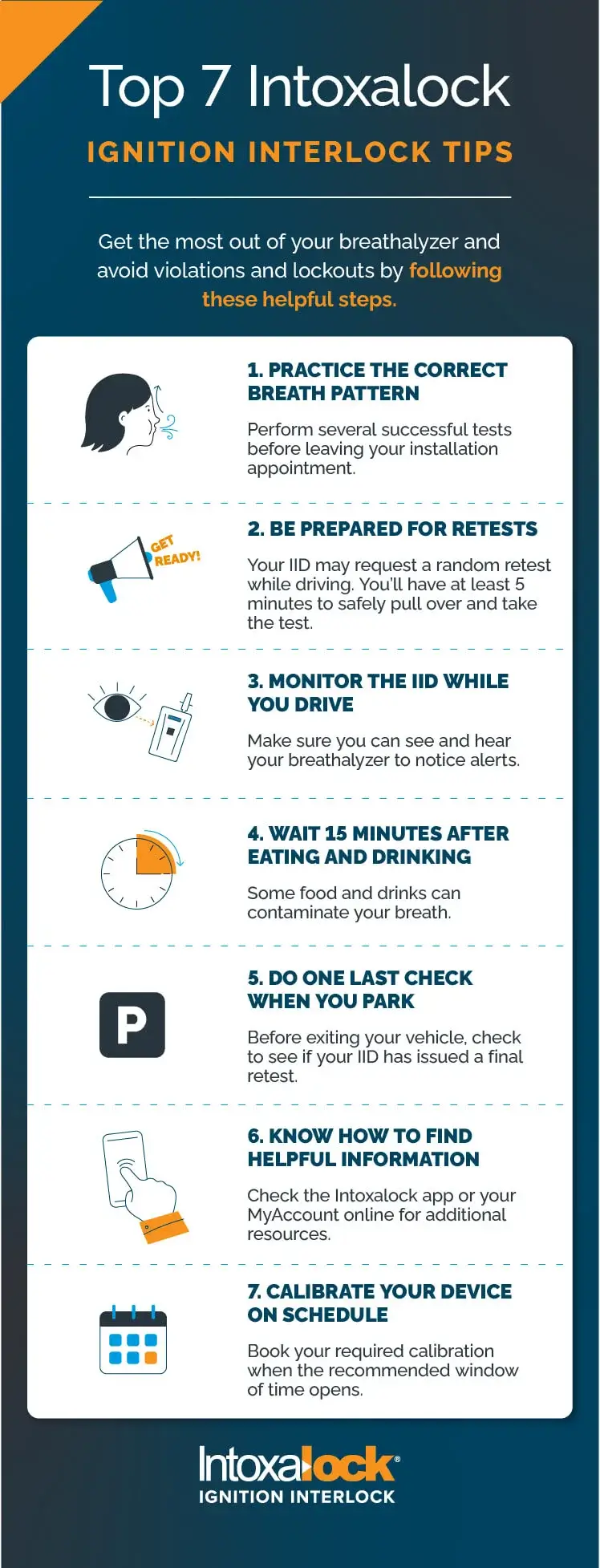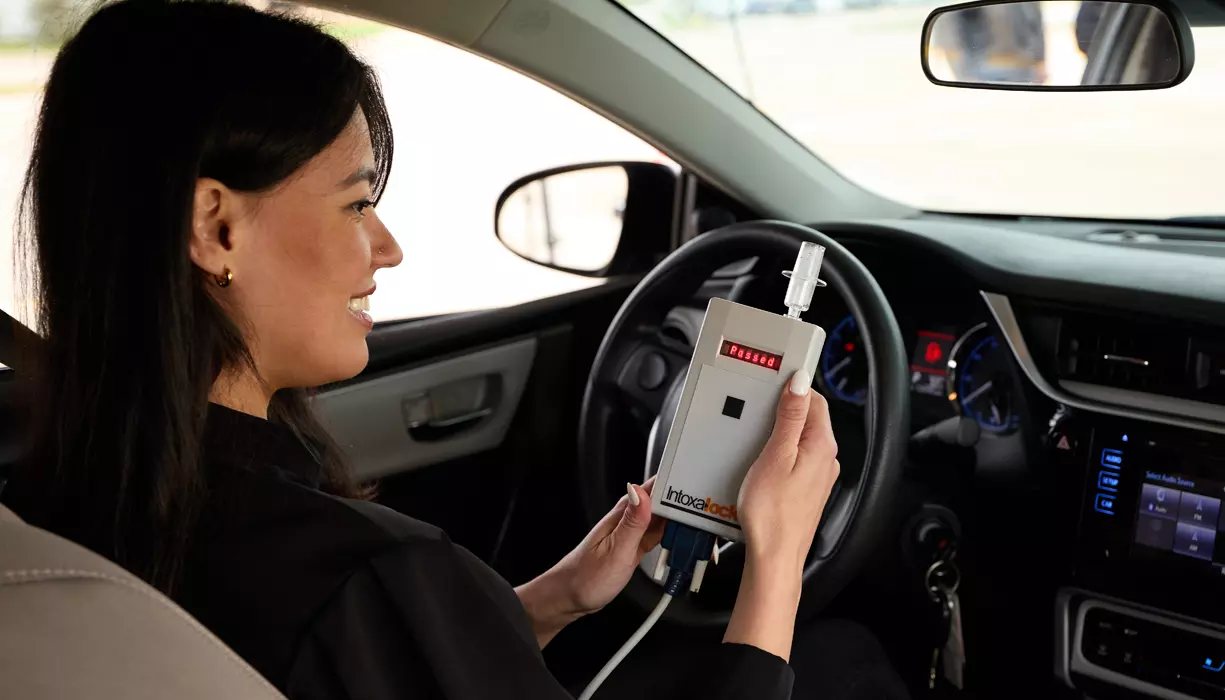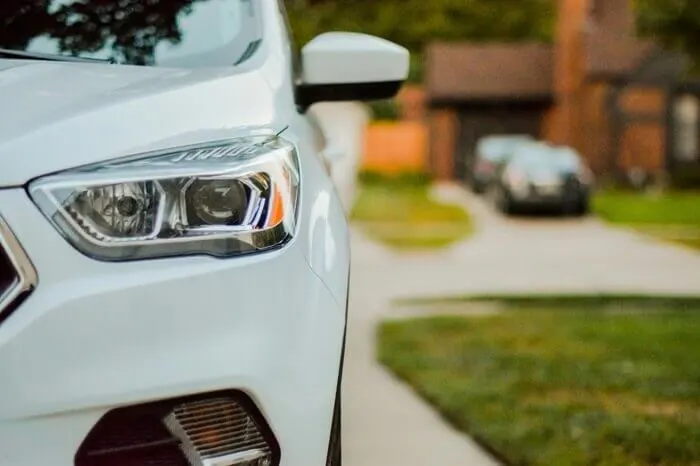Top 7 Car Breathalyzer Tips to Get the Most Out of Your Intoxalock Device

Avoiding ignition interlock violations and lockouts will improve your overall experience and help eliminate costly fines.
Getting a DUI is tough, and adding an ignition interlock device (IID) to your daily routine can make life feel even more complicated. If you don’t use your IID the right way, you could end up facing violations and lockouts, both of which are expensive, time-consuming, and downright frustrating. Every false positive, missed test, or simple mistake can mean more money out of your pocket and more time off the road.
We get it. Nobody wants to deal with extra fees or another day stuck without their car. That’s why we’ve put together these practical tips to help you use your Intoxalock device smoothly. The information in this blog isn’t legal advice, but we do hope it helps you avoid common pitfalls, save yourself stress, and get back to living your life.
If you have more questions about your interlock, give our Intoxalock state specialists a call at (888) 283-5899. We can also point you toward one of our 5,500 service centers nationwide if you need immediate assistance.
How Does an IID Work?
Ignition interlock devices are wired into the ignition system on your vehicle. Before you can start the car, you have to blow into the unit. If it detects alcohol in your breath sample beyond the legal limit, the vehicle won't start. The IID device may lock you out for a few minutes, but the process can vary by state. Once the countdown finishes, you can try again.
When you start driving, the alcohol ignition interlock occasionally asks you to submit more breath samples, which are called "random retests." If those tests fail, the device tells you to pull over. Depending on state law, it might also honk the car's horn or flash its lights until the car is parked and turned off.
Best Practices for Successful IID Breath Samples
Every interlock device is different. To reduce the chance of accidental failures, learn how to provide a breath sample for your device.
For example, Intoxalock device instructions say to use a blow-inhale-blow pattern that mimics natural breathing. Some interlock devices require you to hum while blowing out. This pattern can be tricky if you don’t hum at the correct pitch, which is why Intoxalock often feels easier.
Here are some car breathalyzer tips for successful samples:
- Keep your mouth on the mouthpiece the whole time
- Don't let air leak out of the sides of your mouth
- Breathe steadily during the test
- Stay calm and relaxed
Why IID Violations and Lockouts Happen
IID violations and lockouts are more than just inconveniences. Failing a test or forgetting a retest can have immediate and severe consequences, like a lockout that prevents your vehicle from starting. In many states, repeated violations can extend your IID requirement, result in fines, and even impact your driving privileges.
There’s also the financial toll. Violations and lockouts will trigger extra fees on top of your regular monthly payments. You may face service fees for resolving lockouts, towing expenses, and additional calibration appointments.
Learn more about the most common ignition interlock violations and penalties.
The following tips will help you avoid common mistakes and make your experience as smooth as possible.

Tips to Avoid Device Lockouts
Use these car breathalyzer tips to perform Intoxalock breath tests correctly and avoid lockouts with Intoxalock.
1. Practice the Correct Breath Pattern
If you have an Intoxalock, place the mouthpiece in your mouth and create a seal with your lips. Blow firmly for 1 or 2 seconds (the device will beep every second) then inhale for 1 or 2 seconds and blow again. Keep blowing until the Intoxalock vibrates. This should take about 4 seconds, but it can change based on the force of your breath.
When installing the device, read the Intoxalock device instructions, and ask the technician for several opportunities to practice. This lets you get used to the feeling so you can test confidently before you drive.
2. Be Prepared for Retests
Once you start driving, your IID occasionally asks you to take another breath test. This is designed to prevent people from drinking while driving. It also prevents you from getting another person to blow into the device to start the car.
The number of times you have to complete a retest depends on state law. Before you drive with an interlock device for the first time, check your user guide to find the time limit. All states allow at least five minutes to pull over and submit a random retest. Some allow much more. The user guide should tell you how long your state allows.
When you can, pull over to the side of the road for a retest. That's not always possible, so practice holding the mouthpiece in one hand while keeping the other on the wheel. Keep a few extra mouthpieces in reach in case you lose one.
3. Monitor the IID While You Drive
Keep your IID in a visible spot while driving and turn down the volume on your sound system. These simple steps help you see and hear every notification. That way, you're less likely to miss a retest.
4. Wait 15 Minutes After Eating and Drinking
Mouthwash and other products that contain alcohol can also cause problems. Rinsing your mouth with water before testing can help. You may want to keep a water bottle in your vehicle for convenience.
5. Do One Last Check When You Park
Here's a car breathalyzer test tip that many people forget: When you're done driving, turn the car off and look at your ignition interlock display. Sometimes, it requires you to take a final retest. If not, wait to get out of the vehicle until you see the exit countdown on the display.
6. Research Alerts and Violations
When your device gives you a notification you don't recognize, try some quick Intoxalock troubleshooting. You can check the Intoxalock app or your MyAccount online. The Intoxalock how-to videos offer visual instruction, and the knowledge center provides lots of helpful tips.
7. Calibrate Your Device on Schedule
Once you have an ignition interlock, you need to get it calibrated regularly. The specific schedule depends on state law. In most areas, you need to schedule a calibration every 30-120 days.
If you know a calibration is coming up, book an appointment early to avoid missing the deadline. Intoxalock makes it easy by alerting you in advance and giving you a countdown. On-time calibrations help prevent lockouts and legal consequences.
How to Handle Errors or Failed Tests
Don't panic if you get an error message or a failed test. Look up the meaning of the message in the Intoxalock user guide for ignition interlock device tips and check out the common causes of Intoxalock lockouts to learn what happened. If you see a countdown on the screen, wait until it finishes before trying again.
If you recently ate or drank something containing alcohol, consider waiting longer before retesting. Failing more than one test in a row could cause a lockout.
When you see a lockout message, the process varies based on the cause. Temporary lockouts require waiting between 5 minutes and 24 hours before trying again. The solution for other types of lockouts depends on the cause. You might also need to visit a service center, contact Intoxalock, or charge the battery.
Cleaning and Maintaining Your Device
To keep your Intoxalock clean, remove the mouthpiece and wash it regularly. You can also wipe down the device with a damp cloth.
Staying on Schedule With Your Calibrations
Calibrations are the most important part of Intoxalock maintenance. When you get an ignition interlock device, check the required calibration schedule. Mark the dates on your calendar and put reminders into your phone. Missing a calibration can cause a lockout or violation, so you need to stay on track.
Where to Find Help With Your IID if You Need It
It takes time to get comfortable with an IID device. At Intoxalock, our team is always happy to help. If you have questions about device codes, need more breathalyzer tips, or correct usage, call us at (888) 283-5899 or contact us.




